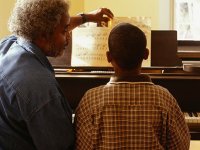It’s a Snap! 4 Ways to Use Music With Special Needs Students
Special ed teachers should consider music in their classrooms to supplement visuals, teach through students’ favorite songs, emphasize rhythm, and generalize lessons into non-musical settings.
I’ve heard Pharrell Williams' song "Happy" a few times in the last week, and the unhappy news is that it's now playing on repeat inside my head . . . over and over and over again. The good news is that we can actually use this scenario to our advantage with our difficult-to-reach students and special learners. Music can often be the key that unlocks the door to learning for children who think outside of the box. In fact, studies have found that individuals with diagnoses such as autism and Williams syndrome frequently have preserved musical abilities despite challenges in non-music functioning.
Capitalizing on these benefits, board-certified music therapists develop music-based interventions to help students make progress in educational goal areas. Music therapy is even recognized by the U.S. Department of Education and states such as California as a related service which may be required for a student to benefit from his or her educational program.
As music therapists, we have the unique opportunity to compose educational songs, write learning chants, and use musical cues to target goals that students are having difficulty meeting. We use music as a motivator, memory tool, timekeeper, and way to elicit communication when other strategies have not been effective. In school settings, music therapists provide consultation, training, and resources to the child's teacher and other members of the IEP team.
Even if you sing off-key, there are many simple ways for integrating music-assisted learning techniques to help your students tune in. Here are four music therapist-recommended strategies to use music as a teaching tool in special education.
1. Music + Visual Supports = Increased Comprehension
While music is an effective memory cue and learning modality, many students still perform best when visual cues are paired with auditory stimuli. Using flash cards, song story books, digital pictures, and even physical gestures can increase students' understanding of the lyrics they are hearing or singing. Here's an example of a song about money with simple visual supports:
2. Favorite Songs as a Teaching Tool
For students who have limited interests or are difficult to engage, try creating a lesson plan around one of their favorite songs. Let's take the earlier example of the song "Happy." Given printed or digital lyric sheets, students can read the song lyrics out loud, identify unfamiliar vocabulary, circle key words, and discuss the song's meaning. Afterward, students can complete a related writing activity based on the central themes in the song.
For younger students, provide pictures or photos that relate to the main characters, animals, objects, or actions from a song. Engage the student in selecting the correct pictures as you sing the words from the song, or have them sequence the pictures in order from memory after listening to the song.
3. Rhythm Is Your Friend
There is a focus in special education (especially with autism intervention) on structuring the student's visual environment. What about auditory information? Verbal instructions and dialog can also be overwhelming for students who have difficulty filtering for the important information they should attend to. Rhythm helps emphasize key words, add a predictable cadence, and naturally gets the body in sync with and tuned into the activity.
Try this simple greeting chant:
- Let’s go 'round in a circle.
- Let’s go 'round in a game.
- When I get to you, tell me, what’s your name?
Students can tap the syllables to their name on a drum to help with their articulation and pacing. Tapping a rhythm on the table, a knee, or a drum is also a great tool for students who speak too fast or are difficult to understand.
4. Generalization Is Key
It's great to see a student who can sing his or her phone number, math facts, or classroom rules through a song, but what happens when music time is over? It's our job as educators to facilitate the generalization of skills from the music to the non-music setting. Some ways to do this include:
- After a song, ask the students "Wh" questions (who, what, when, where, why) about the song content in spoken language.
- Use visual supports from the song during related non-music activities. You might use pictures from a hand-washing song as cues during actual hand washing at the sink.
- Use lyrics from the song as cues throughout the week. If you have a behavioral song cuing the student to keep their hands down, you might start by singing the "hands down" phrase at other times during the day when you see the student becoming restless. Later you can fade the singing into a spoken voice.
Now it's your turn to get those songs out of your head and into the classroom! And please share with us how you use music with your special education students.
